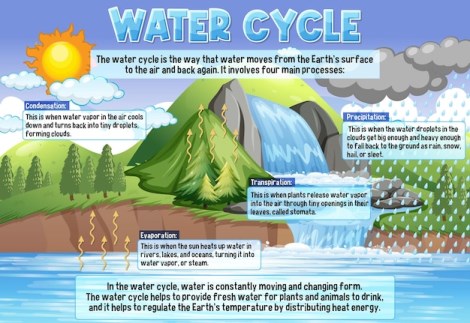Fascinating Facts about the Water Cycle

The water cycle is a continuous process of water movement on Earth.
Water can exist in three states during the water cycle: solid (ice), liquid (water), and gas (water vapor).
The water cycle starts with evaporation, where water changes from a liquid to a gas.
The Sun’s heat is responsible for evaporating water and initiating the water cycle.
Evaporation mainly occurs from oceans, lakes, and rivers, where water is exposed to the Sun’s heat.
When water vapor rises and cools, it condenses to form clouds.
Clouds are made up of tiny water droplets or ice crystals.
Condensation is a crucial part of the water cycle, as it leads to cloud formation.
The formation of clouds is essential for the precipitation process.
Precipitation occurs when condensed water droplets combine and fall to the ground as rain, snow, sleet, or hail.
Rainfall is the most common form of precipitation during the water cycle.
The amount and type of precipitation vary depending on temperature, humidity, and atmospheric conditions.
In colder regions, precipitation often falls as snow, while in warmer regions, it falls as rain.
Snowflakes form when water vapor freezes into ice crystals in the clouds.
Sleet is a type of precipitation that forms when raindrops freeze into ice pellets before reaching the ground.
Hail is a form of frozen precipitation that occurs during severe thunderstorms.
Fascinating Facts about the Water Cycle part 2
Runoff is the movement of water from higher to lower elevations, often resulting in streams, rivers, and eventually, oceans.
Groundwater is another important aspect of the water cycle, as it contributes to the replenishment of lakes, rivers, and oceans.
Transpiration is the process by which plants release water vapor into the atmosphere through their leaves.
Transpiration plays a crucial role in regulating the Earth’s temperature and humidity.
The water cycle helps distribute heat energy throughout the Earth’s atmosphere.
The Earth’s water cycle is a closed system, meaning that no new water is added or lost; it is continuously recycled.
The duration of the water cycle varies from a few days to thousands of years, depending on the path water takes.
The water cycle is vital for sustaining life on Earth, as it provides a constant supply of fresh water.
The water cycle is interconnected with other natural processes, such as weather patterns and ecosystems.
Climate change can influence the water cycle by altering rainfall patterns and increasing evaporation rates.
The water cycle plays a role in regulating temperature extremes on Earth.
The water cycle indirectly affects agriculture, as it determines the availability of water for crops.
Clouds can act as a natural sunscreen, reflecting sunlight and reducing the Earth’s surface temperature.
The water cycle helps regulate ocean currents and temperature distribution.
Water pollution can disrupt the natural water cycle, leading to an imbalance in ecosystems.
The water cycle can contribute to the formation of natural disasters such as hurricanes and cyclones.
The water cycle has been occurring for billions of years and is essential for the planet’s stability.
The water cycle is not limited to Earth; other celestial bodies, such as the Moon, also experience it but in different forms.
Water scarcity in certain regions can be attributed to inadequate precipitation and inefficient water management.
The water cycle helps replenish underground aquifers, which are vital sources of freshwater.
The water cycle is an intricate process that involves multiple scientific disciplines such as meteorology, hydrology, and climatology.
The water cycle is a dynamic process, adapting to different environmental conditions and cyclic patterns.
The water cycle is influenced by various factors, including topography, vegetation cover, and atmospheric pressure.
Cloud seeding is a human-made intervention that aims to modify the water cycle by inducing precipitation.
The water cycle is both gentler and more powerful than it appears, as it shapes landscapes and carves out canyons over time.
Condensation trails, or contrails, formed by aircraft are artificial clouds created as a result of water vapor from engine exhausts.
The water cycle can contribute to the erosion and weathering of rocks, shaping the Earth’s surface.
The water cycle is a captivating natural phenomenon that inspires scientific research and exploration.
The understanding and study of the water cycle are crucial for sustainable water resource management and conservation.

